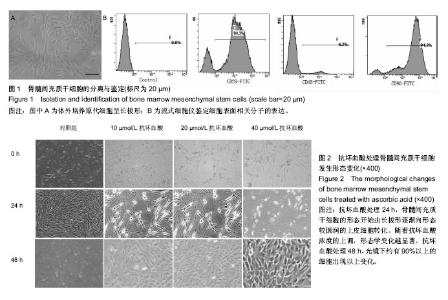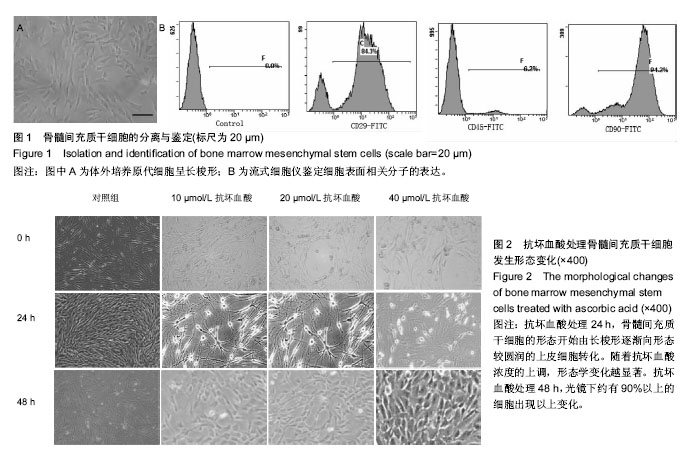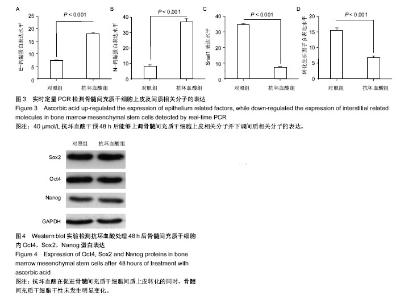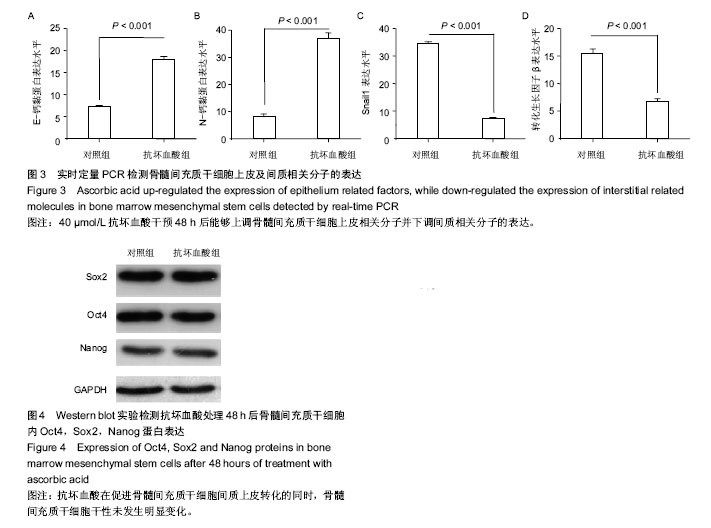| [1] 杨军.组织工程化皮肤及临床应用研究进展[J].国际生物医学工程杂志, 2004, 27(5):274-277.[2] 王宇翀,薛春雨. 组织工程化皮肤的研究进展与展望[J].中国美容整形外科杂志,2015,26(2):115-117.[3] 赵勤鹏. 定向诱导分化环境下骨髓间充质干细胞向成骨及成脂细胞的分化[J].中国组织工程研究,2015,19(32):5103-5107.[4] 陈祁青,金红婷,应俊,等.慢病毒介导TGF-β1基因诱导大鼠骨髓间充质干细胞成软骨细胞分化[J].中国矫形外科杂志,2015, 23(7):637-643.[5] Lui PP, Wong OT, Lee YW. Transplantation of tendon-derived stem cells pre-treated with connective tissue growth factor and ascorbic acid in vitro promoted better tendon repair in a patellar tendon window injury rat model. Cytotherapy. 2016; 18(1):99-112.[6] Xiao L, Miwa N. The Lipophilic Vitamin C Derivative, 6-O-Palmitoylascorbate Protects Human Keratinocytes and 3D-Human Skin Equivalents Against X-Ray-Induced Oxidative Stress and Apoptosis More Markedly Than L-Ascorbic Acid. J Cell Biochem. 2017;118(2):318-329.[7] Coenraads PJ, Vogel TA, Blömeke B, et al. The role of the antioxidant ascorbic acid in the elicitation of contact allergic reactions to p-phenylenediamine. Contact Dermatitis. 2016; 74(5):267-272.[8] Cruz Díaz LA, Flores Miramontes MG, Chávez Hurtado P, et al. Ascorbic acid, ultraviolet C rays, and glucose but not hyperthermia are elicitors of human β-defensin 1 mRNA in normal keratinocytes. Biomed Res Int. 2015;2015:714580.[9] Cubrani? A, Redzovic A, Dobrila-Dintinjana R, et al. Mystery Story about Erythropoietin (Epo) and Erythropoietin Receptor (EpoR) are Disguised. Hepatogastroenterology. 2015;62(139): 585-589.[10] Lam PL, Kok SH, Bian ZX, et al. Microencapsulation- protected l-ascorbic acid for the application of human epithelial HaCaT cell proliferation. J Microencapsul. 2014; 31(8):754-758.[11] 刘阳,傅强.骨髓间充质干细胞成骨分化调控机制研究进展[J].新乡医学院学报,2016,33(5):443-447.[12] 王志红,黄汉,张斌,等.骨髓间充质干细胞促进皮肤创口愈合及Wnt信号通路在愈合过程中的作用[J].中国现代医学杂志,2016, 26(15):56-59.[13] 丁越,张辉,孙晓菊. 骨髓间充质干细胞促进皮肤创伤愈合及细胞因子在愈合过程表达研究[J].中国实用口腔科杂志,2015, 8(2):103-107.[14] Gurav AN. Management of diabolical diabetes mellitus and periodontitis nexus: Are we doing enough. World J Diabetes. 2016;7(4):50-66.[15] Fiordaliso F, Chimenti S, Staszewsky L, et al. A nonerythropoietic derivative of erythropoietin protects the myocardium from ischemia-reperfusion injury. Proc Natl Acad Sci U S A. 2005;102(6):2046-2051.[16] Schöffel N, Börger JA, Quarcoo D, et al. Erythropoietin - state of science. Sportverletz Sportschaden. 2008;22(4):201-206.[17] Xu K, George I, Klotz S, et al. Erythropoietin derivate improves left ventricular systolic performance and attenuates left ventricular remodeling in rats with myocardial infarct-induced heart failure. J Cardiovasc Pharmacol. 2010; 56(5):506-512.[18] Sanchis-Gomar F, Garcia-Gimenez JL, Pareja-Galeano H, et al. Erythropoietin and the heart: physiological effects and the therapeutic perspective. Int J Cardiol. 2014;171(2):116-125.[19] Ogunshola OO, Bogdanova AY. Epo and non-hematopoietic cells: what do we know. Methods Mol Biol. 2013;982:13-41.[20] He H, Qiao X, Wu S. Carbamylated erythropoietin attenuates cardiomyopathy via PI3K/Akt activation in rats with diabetic cardiomyopathy. Exp Ther Med. 2013;6(2):567-573.[21] Xu X, Cao Z, Cao B, et al. Carbamylated erythropoietin protects the myocardium from acute ischemia/reperfusion injury through a PI3K/Akt-dependent mechanism. Surgery. 2009;146(3):506-514.[22] 高缘,张建军,屠锡德.抗坏血酸的新应用[J].药学进展,2000, 24(1):24-26.[23] 曹元华.抗坏血酸2-O-α-糖苷对紫外线致皮肤色素沉着的抑制效果[J].国际皮肤性病学杂志, 1997, 23(5):308-309.[24] Dial WF.Study indicates potential use of vitamins C and E in sunscreens.Cosmet Dermatol. 1996; 9(11):28-29.[25] Cohen HA, Nussinovitch M, Gross S, et al. Treatment of chronic idiopathic thrombocytopenic purpura with ascorbate. Clin Pediatr (Phila). 1993;32(5):300-302.[26] Du M, Pan W, Yang P, et al. Effect of aspirin on cell biological activities in murine bone marrow stromal cells. Zhonghua Kou Qiang Yi Xue Za Zhi. 2016;51(3):160-165.[27] Cao Y, Xiong J, Mei S, et al. Aspirin promotes bone marrow mesenchymal stem cell-based calvarial bone regeneration in mini swine. Stem Cell Res Ther. 2015;6:210.[28] Liu H, Li W, Liu Y, et al. Co-administration of aspirin and allogeneic adipose-derived stromal cells attenuates bone loss in ovariectomized rats through the anti-inflammatory and chemotactic abilities of aspirin. Stem Cell Res Ther. 2015;6:200.[29] Wang JR, Wang CJ, Xu CY, et al. Signaling Cascades Governing Cdc42-Mediated Chondrogenic Differentiation and Mensenchymal Condensation. Genetics. 2016;202(3):1055- 1069.[30] Yan H, Chen T. Progress of research on interaction between bone marrow mensenchymal stem cell and other intra-bone marrow cells.Sheng Wu Yi Xue Gong Cheng Xue Za Zhi. 2013;30(4):889-893.[31] Marques MM, Diniz IM, de Cara SP, et al. Photobiomodulation of Dental Derived Mesenchymal Stem Cells: A Systematic Review. Photomed Laser Surg. 2016;34(11):500-508.[32] Marques MM, Diniz IM, de Cara SP, et al. Photobiomodulation of Dental Derived Mesenchymal Stem Cells: A Systematic Review. Photomed Laser Surg. 2016;34(11):500-508.[33] Carbone A, Valente M, Annacontini L, et al. Adipose-derived mesenchymal stromal (stem) cells differentiate to osteoblast and chondroblast lineages upon incubation with conditioned media from dental pulp stem cell-derived osteoblasts and auricle cartilage chondrocytes. J Biol Regul Homeost Agents. 2016;30(1):111-122. |



